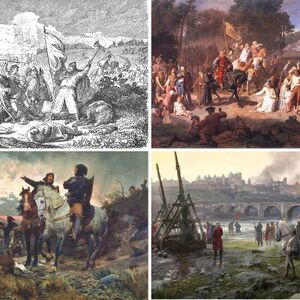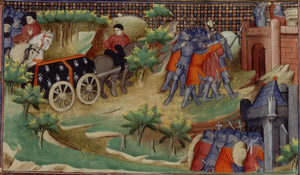Despenser War
| Despenser War | |||||||
|---|---|---|---|---|---|---|---|
 Clockwise, from top left:Bannister Bridge, Eadwyn III after the Battle of Glouth, The Siege of Burgh Despenser, Aftermath of the murder of Eadwyn II | |||||||
| |||||||
| Belligerents | |||||||
|
| Various Vasturian states | ||||||
| Commanders and leaders | |||||||
|
|
| ||||||
| Strength | |||||||
|
Around 18,000 (1322) 10,000 Sjealandic reinforcements (1323) | Around 27,000 (1323 | ||||||
The Despenser War also known as the First War of the Ambrosian Succession, was a conflict fought from 1320 to 1324 between the House of Æthwal, the ruling royal house of Ambrose, and the House of Despenser. The legitimist Æthwallians were supported by the House of Lyksborg, the ruling house of Sjealand, which began actively participating in the war in 1322.
The conflict was rooted in the 1319 death of King Eadwyn I and the ascension of his nephew Eadwyn II to the throne. Eadwyn, who had been raised and educated at the court of Svend III in Sjealand, was deeply unpopular among the nobility and widely regarded as a foreign usurper because of his lenience towards Norcist converts and his inclusion of young Tynic aristocrats at his court. After many nobles were ejected from the royal court, a plot was hatched to place his first cousin Tidweald, Thane of Bothnegowan on the throne, culminating in the Eadwyns murder at Burgh Despenser in 1320. However, rather than retire to exile, the dead Eadwyns brother contested Tidweald's claim, crowning himself Eadwyn III and raising an army of legitimists and mercenaries to his cause.
The war eventually escalated from a minor baronial revolt to a serious civil war as more feudal landowners pledged loyalty to each side; unable to secure decisive advantages, the fighting was characterized by drawn-out sieges and attrition warfare, with campaigning hampered by the short summer months. Eadwyn III was captured and executed in 1321, and replaced by his twelve-year old son as Eadwyn IV (under a regency imposed by his cousin, the Prince of Perth). Through adroit diplomacy, the Prince was able to convince the Svend III, Archking of Sjealand to intervene on the legitimist side, with promises of Svends daughter marrying Eadwyn IV. The battle-hardened and professional Sjealandic forces landed in Elsbridge in the spring of 1323, led by Svend personally, and quickly started an offensive towards the seat of Tidweald.
The armies of Tidweald and met Eadwyn in the autumn of 1324 at the Battle of Bannister Bridge; the battle was the bloodiest in pre-industrial Ambrosian history, with both sides taking over 30,000 casualties combined. The Æthwallian army, exhausted and disorganized after several weeks of campaigning, was attacked piecemeal and annihilated with the loss of its entire remaining leadership; however the Despenserist force was encircled by the late Sjealandic army the next day and destroyed, with Moray bleeding to death on the battlefield. The loss of his last remaining army prompted the former heir apparent to flee to Vasturia, ending the war.
By its conclusion, the war had led to the exile of the House of Despenser and their allied houses (the plurality of the pre-war Ambrosian nobility), denying them the Ambrosian throne. However, Bannister Bridge had also seen the near extinction of the House of Æthwal, with the closest adult candidate being Svend himself, the head of the House of Lyksborg. This caused the crowns of Sjealand and Ambrose to be joined in a personal union, which would become known as the Kingdom of the Two Daughters; this arrangement would persist until the late 1600s. The war also saw separation of most of the Northumbrian baronies from the Ambrosian crown, leading to the coalescence of the Kingdom of Northumbria in 1380.
Origin of the conflict
Ambrosian-Sjealandic relations
State of Ambrose

The reign of King Eadwyn I was generally a peaceful one; aside from several minor civil strife in the vassals of the Northumberland, his rule from 1281 to his death 1319 was marked by a period of prosperity and stability, ensured by the king's adept manipulation of court politics. Despite the king's general popularity, however, problems had begun cropping up: the year before the King's death had seen a severe famine. The nobility to pressure the King, on his deathbed, to relax the taxes levied on the manorial estates; this saw the King's popularity rise but also saw the crown's income (and power) reduced.
Upon the king's death on November 10th, 1319, his son, the Prince of Cornmoor, ascended to the throne as Eadwyn II. Eadwyn II, was unlike his father, very unpopular in Ambrose, especially with members of the landed gentry. This was partially because of his background; the younger Eadwyn had not been raised by in Elsbridge his father but in Asgård—the capital of Sjealand—by his mother, Euphemia of Holmegard (1270-1312), herself of Sjealandic birth. Returning to Ambrose at the age of twenty in 1296, he was was friendless and estranged from the established nobility, who considered him little more than a foreigner; the Prince apparently made little effort to try to ingratiate himself with them. His ascension did little to change this perception; he issued several edicts prohibiting persecution of Norcist converts, and also included numerous young Tynic noblemen to the royal court. In fact, his unpopularity only deepened, with his critics regarding him as a corrupt pagan. The royal court became irrevocably fractured between the King's supporters and his opponents, and the king quickly began ruling by decree instead relying on the fourteen-member baronial council set in place by the 1197 Charter of Liberties.
Seven months into his reign, and in response to the lack of cooperation in the execution his decrees, Eadwyn II raised taxes on the nobility to their previous levels. The nobles protested that their estates remained in famine, viewing the taxes as a pretext for swelling the royal treasury. In response, Eadwyn dismissed nearly half of his court. It was at this point that many nobles began considering deposing the king, by murder if necessary, to prevent the dramatic erosion of their power.